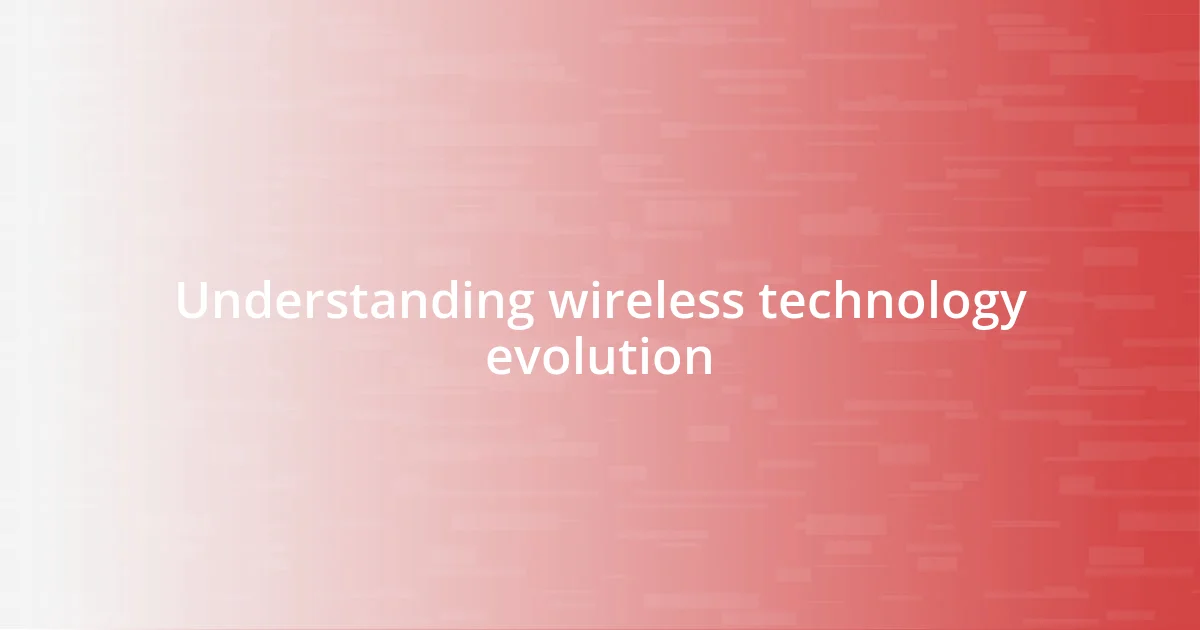Key takeaways:
- The evolution of wireless technology, from 1G to 5G, has significantly improved connectivity, enabling faster communication and transforming daily routines.
- Upcoming standards like Wi-Fi 7, 5G Advanced, and IEEE 802.11ax promise enhanced speeds, reliability, and performance in various environments, impacting industries like healthcare, transportation, and entertainment.
- The integration of AI and advancements in security, such as WPA3 and end-to-end encryption, are enhancing user experience and data protection, fostering trust in wireless technologies.

Understanding wireless technology evolution
Wireless technology has come a long way since its inception. I still remember the time when my family first got a landline-free home, and it felt revolutionary to move around freely while talking. Can you imagine relying on bulky radios and cables? That was a whole different era!
As I reflect on the evolution, I can’t help but marvel at how each leap forward has transformed our daily routines. From 1G to 5G, each generation has introduced faster speeds and more reliable connections, making seamless communication a reality. It sparks a question in my mind: how often do we take this convenience for granted?
Looking ahead, I feel a mix of excitement and curiosity about what’s next. The shift toward technologies like Wi-Fi 6 has begun to redefine how we connect multiple devices. It’s fascinating to think about what the future might hold—can you envision a day when connectivity reaches every corner of our lives, unbothered by barriers?

Key upcoming wireless standards
The upcoming wireless standards are set to revolutionize our connectivity landscape. For instance, Wi-Fi 7 is on the horizon, promising even faster speeds and lower latency compared to Wi-Fi 6. I can’t help but think about how much easier my life will become when I can seamlessly connect multiple devices without worrying about buffering during my favorite shows.
On the horizon, we also have 5G Advanced, which aims to enhance the capabilities of current 5G networks, allowing for improved energy efficiency and reliability. Picture this: I could be in my car, relying on real-time data to navigate traffic smoothly, thanks to these advancements. The thought of being so connected in real-time truly excites me.
Lastly, the emergence of the IEEE 802.11ax standard is worth noting as it facilitates improved performance in congested environments like stadiums or airports. I’ve had my share of struggles while trying to get a signal in crowded spots. Just envisioning a future where everyone can connect effortlessly fills me with anticipation—it’s that promise of better connectivity that keeps me optimistic.
| Wireless Standard | Key Features |
|---|---|
| Wi-Fi 7 | Higher speeds, improved capacity, reduced latency |
| 5G Advanced | Enhanced reliability, efficiency, and real-time data processing |
| IEEE 802.11ax | Optimized performance in crowded areas |

Impact of 5G on industries
The advent of 5G is a real game-changer for numerous industries, ushering in capabilities we’ve only dreamed of until now. I recall a time when my interactions with tech felt limited, but the speed and efficiency 5G introduces are nothing short of astonishing. Imagine a surgeon performing a remote operation with real-time precision—it’s mind-blowing how this technology can redefine what’s possible.
Here’s a glimpse of some industry impacts:
- Healthcare: Enhanced telemedicine with real-time patient monitoring and remote diagnostics.
- Manufacturing: Smart factories utilizing IoT devices for increased automation and efficiency.
- Transportation: Development of autonomous vehicles relying on low-latency communication for safety.
- Entertainment: Streaming high-definition content with virtually no buffering, even in crowded places.
- Agriculture: Precision farming techniques using real-time data for monitoring crop health and resource management.
In addition, I think about how 5G’s impact extends into areas like augmented reality (AR) and virtual reality (VR), which can bring immersive experiences into our homes or workplaces. What I find particularly thrilling is the potential for education—students could access interactive content and virtual classrooms to enhance their learning experiences anytime, anywhere. The idea that 5G could dismantle geographical barriers in education makes me genuinely optimistic about the future.

Future of IoT connectivity
The future of IoT connectivity is undeniably exciting, with advancements promising to create an even more integrated digital ecosystem. When I think about smart homes, I’m reminded of how my own daily routine could transform. Imagine waking up to coffee freshly brewed just in time for when I get out of bed, all thanks to interconnected devices communicating effortlessly—it’s like having a personal assistant at my fingertips.
As we look ahead, the role of Low Power Wide Area Networks (LPWAN) in IoT connectivity can’t be overlooked. The idea of numerous devices communicating over vast distances without draining their batteries is revolutionary. I sometimes recall the frustration of misplaced keys or an out-of-battery tracker when I need it the most. With LPWAN, I envision a future where everything stays connected, and my life is just a little bit easier.
Moreover, the integration of AI into IoT systems is poised to elevate how devices interact with our environment. Imagine an AI that can learn my preferences over time and make adjustments without needing manual input. Last week, I noticed how my smart thermostat adjusted the temperature subtly throughout the day, aligning perfectly with my routine. If that’s just the beginning, I can’t wait to see what’s next in this ongoing evolution of connectivity. How could such seamless integration enrich our daily experiences even further? I’m truly looking forward to finding out.

Enhancements in wireless security
Enhancements in wireless security are becoming a top priority as we embrace the next generation of connectivity. I remember when I used to feel a sense of unease about using public Wi-Fi; the thought of my data being vulnerable was nerve-wracking. Now, with advancements like WPA3—an improved security protocol that strengthens password protection and safeguards against brute-force attacks—I feel a sense of reassurance. I often wonder how many people are truly aware of these enhancements or if they remain oblivious to the dangers that come with unprotected networks.
Looking at the integration of machine learning in security systems, I can’t help but reflect on how much more secure our devices are becoming. Just last week, I received a message alerting me that an unknown device was trying to connect to my network. It was comforting to know that my router could automatically recognize potential threats and take action to protect my personal information. This proactive approach to security makes me believe that as technology continues to evolve, it will offer us even smarter solutions to keep our data safe.
Moreover, the rise of end-to-end encryption is a game-changer in the wireless security landscape. When I send sensitive information, knowing that it remains encrypted until it reaches its destination gives me a sense of peace. It’s like putting my secrets in a safe that only the intended recipient can unlock. I often think about how this level of security could encourage more people to engage with digital platforms. Have you ever hesitated to share something online out of fear? I suspect many have, but I believe that these ongoing enhancements may soon change minds and foster greater trust in wireless technologies.

Anticipating user experience changes
I often think about how user experience will change as wireless technology evolves, especially with the integration of 5G. The speed is mind-blowing! Just the other day, I tried streaming a high-definition show on my phone while waiting for a friend at a café. The seamless experience—no buffering, no lag—made me realize just how much a fast connection can enhance our daily interactions. Will we soon take instantaneous streaming and real-time sharing for granted? I know I already do.
As I consider emerging technologies like augmented reality (AR) and virtual reality (VR), I can’t help but feel a sense of excitement. Imagine walking through a store while an AR app displays product information right in front of your eyes. I remember feeling overwhelmed shopping during the holidays, but with such tools, I might find it easier to navigate and make choices. Will this create a more immersive retail experience? I believe it will—transforming mundane tasks into engaging adventures.
I also wonder about the role of voice-activated assistants in shaping user interactions. I recently decided to try a smart speaker, and it felt like having a conversation with a friend who knows me well. The ease of asking for quick information or controlling my home environment without lifting a finger is a game changer. However, will we become too reliant on these devices? I see a fine line, and I’m curious how this balance will unfold as these technologies become more integrated into our lives.












